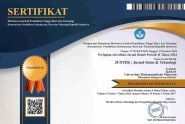HASIL BELAJAR FISIKA DITINJAU DARI KECERDASAN EMOSIONAL SISWA SMA NEGERI 2 SEKAMPUNG
Abstract
Abstrak: Tujuan penelitian ini adalah mendeskripsikan tingkat keberhasilan belajar fisika ditinjau dari kecerdasan emosional, kontribusi kecerdasan emosional terhadap hasil belajar, kesesuaian hasil belajar dengan tingkat kecerdasan emosional, pola dukungan subvariabel kecerdasan emosional yang terbentuk pada variasi kategori hasil belajar. Populasi pada penelitian ini adalah seluruh siswa SMA Negeri 2 Sekampung, sampel diambil 20% dari populasi atau sebanyak 35 siswa. Data diperoleh melalui metode tes dan angket kecerdasan emosional. Kesimpulan: (1) Siswa yang memiliki kecerdasan emosional tinggi maka tingkat keberhasilan belajar paling besar, (2) kontribusi kecerdasan emosional terhadap hasil belajar sangat besar, (3) hasil belajar sesuai dengan kecerdasan emosional, (4) pola dukungan subvariabel kecerdasan emosional pada hasil belajar tinggi, yaitu siswa memiliki kesadaran diri, pengaturan diri, turut merasakan (empati), dan keterampilan sosial tinggi, pola dukungan subvariabel kecerdasan emosional pada hasil belajar sedang, yaitu siswa memiliki kesadaran diri, pengaturan diri, turut merasakan (empati), dan keterampilan sosial sedang, pola dukungan subvariabel kecerdasan emosional pada hasil belajar rendah, yaitu siswa memiliki kesadaran diri, pengaturan diri, turut merasakan (empati), dan keterampilan sosial rendah. Subvariabel kecerdasan emosional yang dominan mendukung hasil belajar adalah turut merasakan (empati).
Abstract: The purpose of this study was to describe the success rate to learn physics in terms of emotional intelligence, emotional intelligence contribute to learning outcomes, learning outcomes conformity with the level of emotional intelligence, emotional intelligence subvariabel support pattern formed on the variation of categories of learning outcomes. The population in this study were all students of SMA Negeri 2 Sekampung, samples taken 20% of the population, or as many as 35 students. Data obtained through the method of emotional intelligence tests and questionnaires. Conclusions: (1) Students who have high emotional intelligence the greatest learning success rate, (2) contribution of emotional intelligence to the learning outcomes is very large, (3) learning outcomes in accordance with emotional intelligence, (4) a pattern of emotional intelligence subvariabel support the results higher learning, the students' self-awareness, self-regulation, also feel (empathy), and high social skills, emotional intelligence subvariabel patterns support the learning outcomes were, the students have self-awareness, self-regulation, also feel (empathy), and skills social being, patterns support emotional intelligence subvariabel low learning outcomes, the students have self-awareness, self-regulation, also feel (empathy), and low social skills. Subvariabel emotional intelligence is the dominant support learning outcomes also feel (empathy).Keywords
Full Text:
PDFDOI: https://doi.org/10.31764/justek.v1i1.413
Refbacks
- There are currently no refbacks.
JUSTEK : Jurnal Sains dan Teknologi sudah terindeks
EDITORIAL OFFICE:












.JPG)

